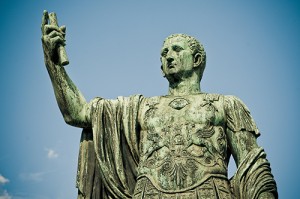 The blog post this week comes out of my personal curiosity with traditions and their origins. It started with the origins of the Ides of March and then snowballed to Mardi Gras and St. Patrick’s Day. I am hoping that you learn something new from my research. If anything, it will arm you with new party conversation topics.
The blog post this week comes out of my personal curiosity with traditions and their origins. It started with the origins of the Ides of March and then snowballed to Mardi Gras and St. Patrick’s Day. I am hoping that you learn something new from my research. If anything, it will arm you with new party conversation topics.
I knew that Caesar was killed by Brutus and Cassius on the fifteenth, or the Ides of March, but I assumed that there was more to it than that. The Roman months were broken up into three parts. The Kalends was the first day of the month, the Nones was thought to be the date of the half moon and the Ides is thought to be the day of the full moon or the “half division” of the month. In 44 BCE, the year of the death of Julius Caesar, the half division fell on March 15, which has been chronicled by historians. This significance would have died out long ago, had it not been for a play by William Shakespeare in which the soothsayer character utters the line “Beware the Ides of March.” It is amazing to think that because of powerful prose, we still think about this event over 2,000 years later.
Mardi Gras
I know enough French to understand that Mardi Gras means “fat Tuesday,” and that it is tied to the beginning of Lent, but who started the whole thing about parties and parades? It turns out that Mardi Gras dates back thousands of years to pagan spring and fertility rites. When the Christian church was established, rather than doing away with traditional pagan rituals, they folded them into their own rites. Thus, Mardi Gras came to be the Tuesday before the beginning of Lent, a time of fasting and reflection. In the days before Lent, households would traditionally eat up all of the meat, eggs, milk, and cheese in the house and prepare themselves for the period where they would eat only fish or fast. The term “Carnival” comes from the ancient word “carnelevarium”—to remove or take away meat. Today, Louisiana is the only US state where Mardi Gras is a legal holiday.
St. Patrick’s Day
Who was this guy and why do we dress in green to celebrate him? St. Patrick is the patron saint of Ireland and is credited with bringing Christianity to the emerald isle. St. Patrick’s day is observed on March 17 to commemorate his death in 461 CE and it always falls on Lent (see Mardi Gras above). The Irish tradition has been to attend church in the morning and celebrate in the afternoon and evening. Lenten prohibitions against eating meat were waved and Irish families feasted on bacon and cabbage. St. Patrick was known to use the shamrock in his teaching, so the Irish began to wear shamrocks and then later dressed in green to celebrate. This legend and tradition spread to America after the Irish potato famine drove many Irish to emigrate. The first St. Patrick’s Day parade was actually held in New York and not in Ireland. The next time you celebrate St Patrick’s Day by donning green, think of the Christian missionary who died more than 1,500 years ago.
Thoughts
I hope this excursion has left you with some facts that you did not know. I hope it also leaves you wondering about the origins of other traditions and inspires you to do some of your own research. Asking questions about any tradition is a great way to grow and become smarter about the world around us. I wonder why we… ?
Kelly Brown is an IT professional, adjunct faculty for the University of Oregon, and academic director of the UO Applied Information Management Master’s Degree Program. He writes about IT and business topics that keep him up at night.

